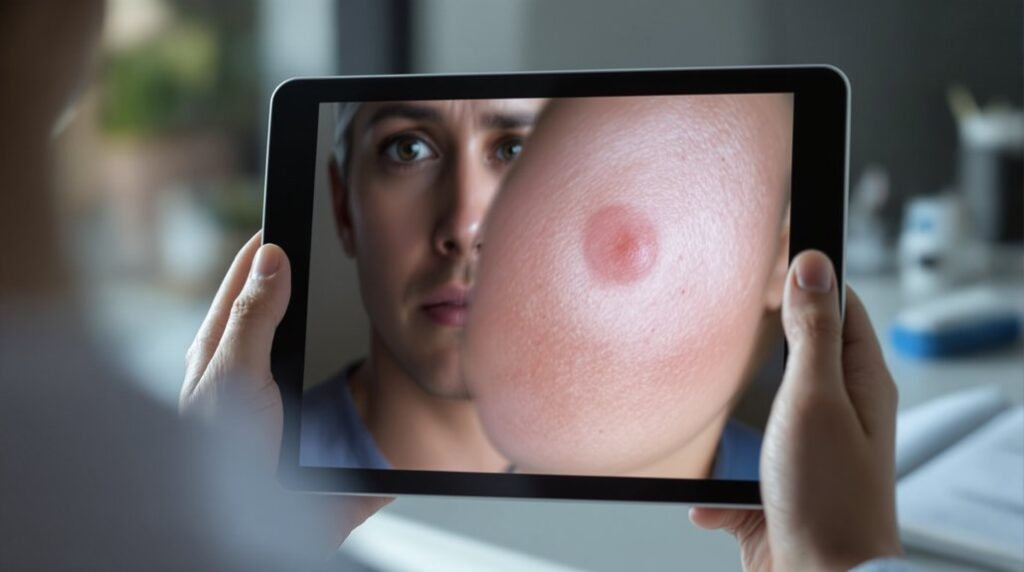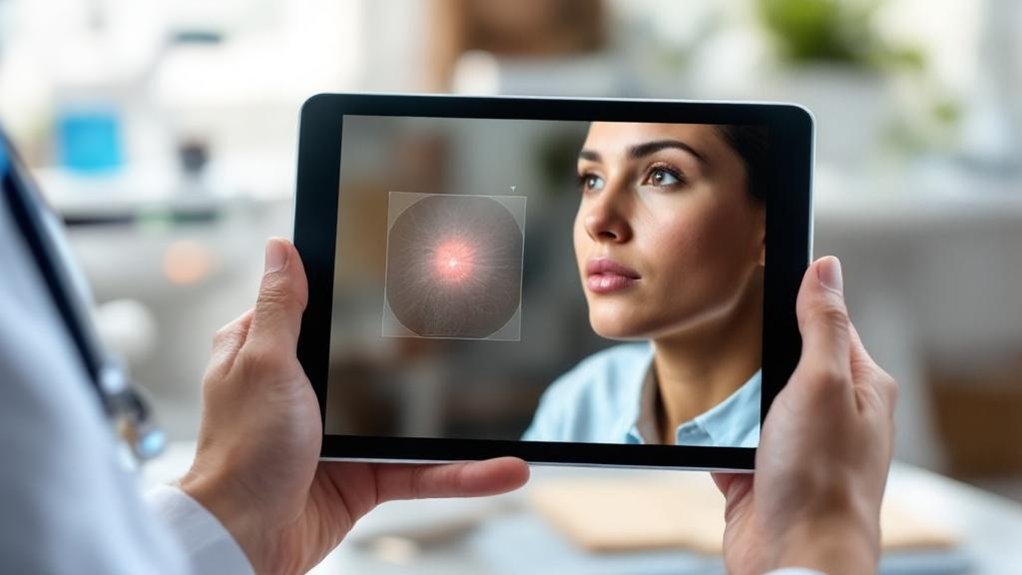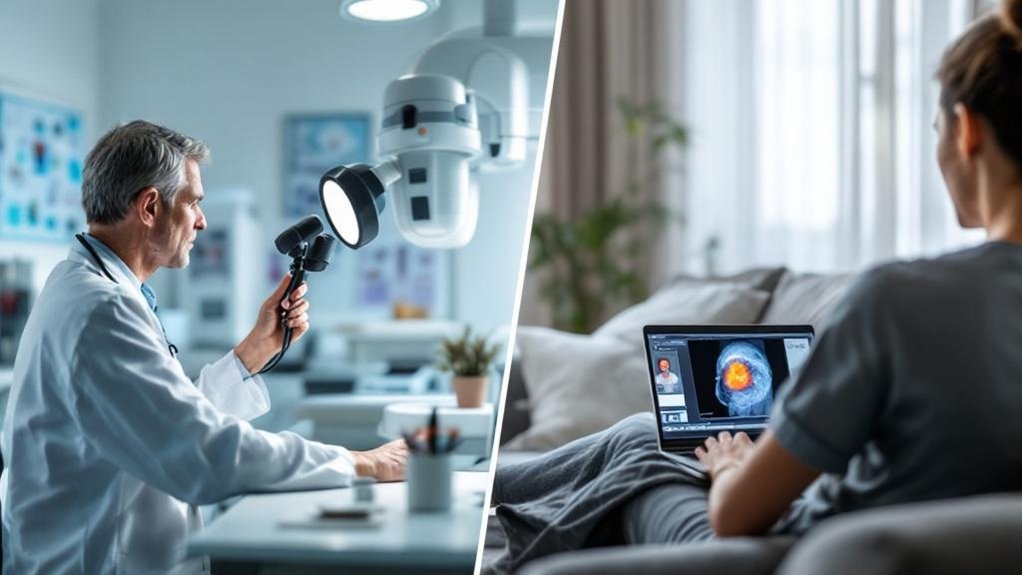Posted by: Skin And Cancer Institute in Skin Cancer

Yes, you can consult for skin cancer radiation therapy online. Virtual consultations allow for treatment planning, follow-up care, and symptom monitoring with comparable efficacy to in-person visits. Medicare covers telehealth radiation management through December 2024. However, not all cases are suitable—complex tumors, poorly defined margins, and aggressive cancers require in-person assessment. Appropriate patient selection and robust technical infrastructure are essential for successful telehealth radiation oncology care.
Key Takeaways
- Virtual consultations for radiation therapy planning are possible, but with specific limitations based on cancer type and complexity.
- Radiation oncologists can effectively review digital medical records and imaging studies remotely to develop treatment plans.
- Medicare extends telehealth flexibility for radiation treatment management through December 2024, making online consultations accessible.
- Patients with high-risk pathologic features, large tumors, or anatomically complex areas are not suitable for virtual planning.
- Follow-up care after radiation therapy shows high success rates through telemedicine, with 83% of patients reporting successful symptom monitoring.
Current State of Teledermatology for Skin Cancer Diagnosis

As dermatology practices increasingly adopt telehealth solutions, the current landscape of teledermatology for skin cancer diagnosis reveals both promising advancements and significant challenges. Recent teledermatology trends show it’s becoming an essential optimization tool in resource-limited settings, with studies demonstrating shortened diagnostic processes for dermatologists. Advanced screening technologies including digital dermoscopy techniques have significantly improved detection accuracy while reducing instances of overdiagnosis.
The urgency for effective telehealth solutions is underscored by alarming skin cancer statistics: approximately 5.4 million Americans are diagnosed with basal or squamous cell carcinomas annually, while melanoma cases are projected to reach 212,200 by 2025—a 42% increase over the past decade. Despite this growing demand, implementation faces obstacles including prolonged referral times (averaging 76 days) and regional disparities in care access. We’re witnessing promising efficiency gains, but standardized protocols remain necessary to address waiting times that exceed international recommendations. Recent data from the Chilean teledermatology platform shows an average response time of 3.98 days for diagnostic suggestions, demonstrating the potential for rapid initial assessment.
Virtual Consultations for Radiation Therapy Planning
Virtual consultations represent a significant advancement in radiation therapy planning for skin cancer patients, extending the reach of specialized dermatological expertise beyond physical clinic boundaries. The process typically begins with our radiation oncologists reviewing digital medical records, pathology reports, and imaging studies—a workflow that studies show maintains clinical effectiveness without compromising patient safety. These remote sessions allow for preliminary discussions about treatment positioning options, which is a crucial first step in the radiation oncology treatment simulation process. For non-melanoma skin cancers, radiation therapy can achieve success rates between 84-99% while preserving healthy surrounding tissue.
Nearly 88% of radiation oncologists report that telehealth experiences exceeded their expectations, with most feeling equally comfortable making treatment recommendations virtually. These virtual consultation benefits are particularly valuable for patients in remote locations seeking subspecialized care. While simulation processes generally require in-person visits for CT scans and immobilization device creation, initial consultations and follow-ups shift well to digital platforms, enhancing telehealth patient engagement throughout the treatment journey.
Technical Requirements for Remote Radiation Therapy Assessments

The implementation of effective remote radiation therapy assessments requires extensive technical infrastructure and specialized systems designed for secure, accurate treatment planning.
We’ve found that successful remote access systems demand rigorous security configurations with integration between critical platforms like Eclipse Treatment Planning System and linear accelerator interfaces. Software integration between CT scanners, AI contouring tools, and treatment planning systems is essential but challenging across multiple hospital systems. Quality assurance protocols must include independent verification of dosimetric accuracy and patient immobilization systems. All treatment documentation must precisely detail radiation modality, dose parameters, and fractionation schedules.
Additionally, credentialing requirements for radiation therapists include demonstrated competence in contouring, planning, and image registration. Established workflows now allow for RTT-led staffing models that address physician availability barriers in remote adaptive treatment scenarios. Communication protocols must establish secure channels for multidisciplinary collaboration while protecting sensitive patient data.
Benefits and Limitations of Online Radiation Therapy Consultations
We’ve found that online radiation therapy consultations allow expert development of pretreatment plans without requiring patients to travel to specialized centers. Remote access to radiation oncology specialists offers substantial benefits for geographically distributed populations, with 85.7% of patients reporting excellent communication quality during virtual consultations. These virtual consultations can also include discussions about non-surgical options like superficial radiation therapy for patients who are not surgical candidates. While facilitating efficient follow-up care coordination, these consultations have limitations in evaluating certain treatment-related toxicities, particularly skin reactions from breast radiation. The TelePORT study demonstrated that physicians could accurately assess patient symptoms, with 82.3% feeling capable of evaluating treatment-related toxicity through telehealth visits.
Pretreatment Plan Development
Determining whether radiation therapy planning can be effectively conducted through telemedicine requires careful consideration of both capabilities and constraints. Virtual examination challenges greatly impact pretreatment planning for skin cancers, as subtle physical findings and early radiation dermatitis cannot be reliably assessed remotely. Extensive skin assessment limitations prevent thorough evaluation necessary for accurate treatment planning.
While evidence shows virtual radiation oncology consultations can maintain safety and patient satisfaction, a hybrid approach remains ideal. Full-body skin examinations and dermatoscopic evaluations essential for skin cancer assessment cannot be replicated virtually. For pretreatment planning specifically, telemedicine works best as a triage tool rather than a complete substitute for in-person evaluation. Implementing a hybrid care model that combines virtual consultations with in-person assessments provides the most comprehensive approach to radiation oncology care. We’ve found that initial skin cancer diagnosis typically requires physical examination, with virtual platforms better suited for follow-up care and managing already-diagnosed conditions.
Remote Expertise Access
Access to remote radiation oncology expertise through telemedicine consultations offers significant benefits alongside notable limitations for skin cancer management. Studies show approximately 92% of radiation oncology visits successfully shifted to virtual formats during the pandemic, with no serious patient safety events reported.
Remote collaboration connects patients with specialists regardless of location, particularly valuable for those requiring daily radiation treatments. Expert networks enable multidisciplinary discussion of complex cases without patient travel burden. Telemedicine options may be particularly beneficial for elderly patients who face mobility challenges with traditional radiation therapy schedules.
However, significant limitations exist in physical assessment capabilities. While 82% of physicians report accurate toxicity evaluation remotely, specific challenges arise with skin toxicity assessment—crucial for radiation dermatitis monitoring. Virtual formats struggle with detecting subtle changes that require palpation or direct visualization.
We recommend a hybrid approach that leverages telemedicine’s convenience while maintaining essential in-person assessments for ideal skin cancer care.
Follow-up Care Coordination
Although radiation therapy remains a cornerstone of skin cancer treatment, the follow-up care paradigm has shifted considerably with telemedicine integration. Research demonstrates that virtual follow-up visits maintain clinical effectiveness while markedly reducing patient burden.
Our radiation patients benefit from reduced travel expenses, decreased time off work, and shorter wait times—all contributing to enhanced patient engagement. Through virtual platforms, we’re able to incorporate Patient-Reported Outcome Measures, enabling earlier detection of skin reactions and radiation toxicity. Multidisciplinary teams are essential for coordinating comprehensive telehealth care plans across oncology specialties.
Care continuity remains strong despite the virtual format, with studies showing no impairment in recurrence detection compared to traditional visits. However, limitations exist regarding detailed skin assessment, as ideal image quality depends on lighting conditions and camera capabilities. For unexpected skin changes or new lesions, we still recommend in-person evaluation to guarantee thorough care.
Patient Selection Criteria for Virtual Radiation Planning
When selecting patients for virtual radiation planning, strict adherence to established criteria guarantees ideal treatment outcomes while minimizing risks. Through virtual screening criteria, we exclude patients with high-risk pathologic features (morpheaform, infiltrative patterns, perineural invasion), tumors exceeding 20mm diameter or 4mm depth, and those on irregular surfaces.
Remote assessment challenges exist for patients with poorly defined margins, genetic radiation sensitivity disorders (xeroderma pigmentosum), collagen vascular diseases, or poorly controlled diabetes (HbA1c >7%). We cannot virtually plan radiation for anatomically complex areas (eyelids, lips), tumors over bone, or those with full thickness involvement. Patients with more aggressive types like Merkel Cell Carcinoma, which progresses quickly and requires prompt intervention, are generally not suitable candidates for virtual radiation planning.
At the Skin and Cancer Institute, we carefully evaluate each case, ensuring only appropriate candidates proceed to virtual radiation planning, maintaining our 90-95% cure rates while prioritizing patient safety. The virtual assessment must incorporate high-frequency ultrasound techniques to accurately measure tumor depth from the epidermal surface to the deepest point.
Clinical Outcomes of Telehealth-Facilitated Radiation Treatment

The clinical outcomes of telehealth-facilitated radiation treatment have demonstrated remarkable safety profiles in recent studies, with our extensive analysis revealing no serious adverse events during fully remote radiation oncology care. Remote monitoring has maintained comparable efficacy to traditional in-person standards, with research confirming no negative impact on established treatment metrics.
While telehealth effectiveness remains strong across multiple cancer types, challenges exist in thorough toxicity assessment, with only 82.3% of physicians reporting confidence in remote evaluation of skin reactions. Despite these limitations, 83% of patients confirmed successful symptom monitoring, though perspectives varied by disease stage.
At our practice, we’re committed to maintaining the high cure rates and quality-of-care indexes seen in conventional radiation treatment through carefully designed telehealth protocols. Electronic brachytherapy’s non-invasive approach makes it particularly suitable for remote consultation and follow-up care in appropriate cases.
Regulatory Considerations for Remote Radiation Therapy Consultations
Steering through the complex regulatory landscape of remote radiation therapy consultations requires careful attention to evolving telehealth policies that directly impact our practice.
Medicare’s extension of telehealth flexibility for radiation treatment management (CPT 77427) through December 2024 affects how we deliver care, but ASTRO has requested its removal beginning 2025. We’re now mandated to use fully HIPAA-compliant platforms for all virtual visits since August 2023.
Interstate practice presents additional challenges—providers must navigate licensure requirements in patients’ states, as most jurisdictions prohibit cross-border telehealth without proper licensing. The Interstate Medical Licensure Compact offers some relief, but doesn’t automatically apply to radiation oncology services. Physicians must obtain informed consent from patients before providing any telehealth services, including documentation in medical records of the limitations and risks specific to remote radiation therapy consultations.
Maintaining regulatory compliance while meeting telehealth guidelines requires continuous monitoring of state-specific regulations, privacy laws, and professional society positions that govern remote radiation therapy consultations.
Comparing In-Person vs. Virtual Radiation Therapy Assessments

Despite initial skepticism, thorough comparison of in-person versus virtual radiation therapy assessments has yielded encouraging results for telehealth implementation. Studies report zero serious events during remote care, with 71% of radiation oncologists noting no difference in treatment capability. The patient experience has been overwhelmingly positive, with completion rates reaching 100% in some follow-up scenarios. Recent data from Memorial Sloan Kettering shows that 98% of patients rated their telehealth radiation therapy experience as good to very good.
Assessment accuracy remains high for most evaluations, with 80% of cosmetic outcomes consistently identified regardless of consultation method. However, limitations exist—17.7% of physicians reported difficulty evaluating radiation-induced skin toxicity remotely, and palpation-dependent findings remain challenging. This is particularly relevant for Arizonans who face higher UV exposure due to the state’s 300+ days of sunshine annually. These findings support a hybrid approach where we reserve in-person visits for physical examinations while conducting initial consultations and routine check-ins virtually, balancing safety with clinical precision.
Future Developments in Telemedicine for Skin Cancer Treatment
As telemedicine continues evolving in oncology care, four revolutionary technologies are poised to transform skin cancer management in the coming decade. AI advancements in dermoscopy now achieve up to 89% diagnostic accuracy, comparable to in-person examinations. We’re particularly excited about deep learning systems that differentiate between benign moles and melanoma with over 95% sensitivity. Remote physician consultation combined with tumor-infiltrating lymphocyte therapy has shown remarkable results for advanced skin cancers in preliminary telemedicine trials.
Telemedicine integration with nanotechnology offers unprecedented precision in treatment monitoring. Smart nanosensors will soon provide real-time biochemical feedback on treatment efficacy, transmitted directly to our physician portals. For patients requiring more intensive treatment, our platform offers consultations for checkpoint inhibitors that harness the body’s immune system to fight advanced melanoma. Meanwhile, our patient-centric surveillance ecosystems enable clinical-grade imaging from home, creating thorough digital baselines for early detection. These innovations will dramatically expand access to specialist care, especially for rural and underserved communities where we’ve already reduced consultation wait times by 60%.
Frequently Asked Questions
Are Radiation Therapy Consultations Covered by Insurance When Done Online?
Insurance policies vary for online consultations regarding radiation therapy. We’ve seen Medicare extend coverage through 2024, while private insurers follow state-specific reimbursement laws. We recommend verifying your specific coverage before scheduling.
What Specific Skin Cancers Are Suitable for Telemedicine Radiation Therapy Planning?
We primarily offer telemedicine radiation planning for non-melanoma cancers like basal carcinoma. Melanoma management typically requires in-person evaluation due to its aggressive nature and more complex treatment requirements.
How Do I Prepare My Home Environment for a Virtual Radiation Consultation?
We recommend creating a quiet space with privacy, good lighting, stable internet, and virtual setup on a compatible device. Distraction reduction is essential for successful radiation consultation and ideal visual assessment.
Can Family Members Participate in Online Radiation Therapy Consultations?
Yes, we welcome family involvement in our virtual radiation consultations. Family members can provide valuable virtual support while we adhere to HIPAA protocols for patient privacy and confidentiality during telehealth sessions.
What Follow-Up Protocols Exist for Telehealth Radiation Therapy Patients?
We conduct routine follow-up assessments 4-8 weeks post-radiation, with weekly treatment monitoring via telehealth during active therapy. Our protocols include video visits to evaluate skin reactions and patient-reported outcome measures for toxicity detection.
Conclusion
We’ve examined telemedicine’s role in radiation therapy planning for skin cancer patients. While virtual consultations can supplement care through pre-assessments and follow-ups, they cannot fully replace initial in-person evaluations that require physical examination and precise measurements. The evidence supports a hybrid approach that combines telemedicine’s accessibility with traditional assessments, allowing us to extend specialized care to more patients while maintaining treatment quality and safety standards.